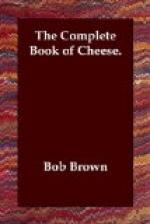If there’s a chafing dish handy, a first-rate nightcap can be made via a
Sauteed Swiss Sandwich
Tuck a slice of Swiss cheese between two pieces of thickly buttered bread, trim crusts, cut sandwich in two, surround it with one well-beaten egg, slide it into sizzling butter and fry on both sides. A chef at the New York Athletic Club once improved on this by first sandwiching the Swiss between a slice of ham and a slice of chicken breast, then beating up a brace of eggs with a jigger of heavy sweet cream and soaking his sandwich in this until it sopped up every drop. A final frying in sweet butter made strong men cry for it.
[Illustration]
Chapter Ten
Appetizers, Crackers, Sandwiches, Savories,
Snacks, Spreads and Toasts
In America cheese got its start in country stores in our cracker-barrel days when every man felt free to saunter in, pick up the cheese knife and cut himself a wedge from the big-bellied rattrap cheese standing under its glass bell or wire mesh hood that kept the flies off but not the free-lunchers. Cheese by itself being none too palatable, the taster would saunter over to the cracker barrel, shoo the cat off and help himself to the old-time crackers that can’t be beat today.
At that time Wisconsin still belonged to the Indians and Vermont was our leading cheese state, with its Sage and Cheddar and Vermont Country Store Crackers, as Vrest Orton of Weston Vermont, calls them. When Orton heard we were writing this book, he sent samples from the store his father started in 1897 which is still going strong. Together with the Vermont Good Old-fashioned Natural Cheese and the Sage came a handy handmade Cracker Basket, all wicker, ten crackers long and just one double cracker wide. A snug little casket for those puffy, old-time, two-in-one soda biscuits that have no salt to spoil the taste of the accompanying cheese. Each does double duty because it’s made to split in the middle, so you can try one kind of cheese on one half and another on t’other, or sandwich them between.
Some Pied Piper took the country cheese and crackers to the corner saloon and led a free-lunch procession that never faltered till Prohibition came. The same old store cheese was soon pepped up as saloon cheese with a saucer of caraway seeds, bowls of pickles, peppers, pickled peppers and rye bread with plenty of mustard, pretzels or cheese straws, smearcase and schwarzbrot. Beer and cheese forever together, as in the free-lunch ditty of that great day:
I am an Irish hunter;
I am, I ain’t.
I do not hunt for deer
But beer.
Oh, Otto, wring the bar rag.
I do not hunt for fleas
But cheese.
Oh, Adolph, bring the free
lunch.
It was there and then that cheese came of age from coast to coast. In every bar there was a choice of Swiss, Cottage, Limburger—manly cheeses, walkie-talkie oldsters that could sit up and beg, golden yellow, tangy mellow, always cut in cubes. Cheese takes the cube form as naturally as eggs take the oval and honeycombs the hexagon.




